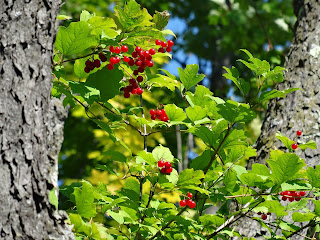At over 33 square kilometers in area, this conservation area is massive, and a real gem in such close proximity to Ottawa. The highlight is the large peatbog dominated by Leatherleaf, Black Spurce, Tamarack, Cottongrass and other typical acid-loving bog species. The boardwalk itself is rather short, 1.2km I believe, but just long enough to give visitors an appreciation for this ecosystem. I was a little surprised that the first interpretive sign I encountered touted peatlands as the largest untapped energy source and an alternative to fossil fuels. Fortunately the signage to follow spoke to the local significance of this feature and the role that peatlands and wetlands in general play in biodiversity on a larger scale.
This photo shows a portion of the boardwalk, it's interesting moving from the treed upland sand ridge, down into cattail marsh, then on to a low shrub community, then through portion of treed bog. While I didn't come up with much in the way of wildlife on this short visit, you can certainly understand why Mer Bleue is a hotspot for birds and butterflies.
The whitish underside of the deeply-veined Bebb's Willow (Salix bebbiana) leaves.
This young Midland Painted Turtle was happy to bask alongside the boardwalk.
Unfortunately among the cattails, European Frog's-bit (Hydrocharis morsus-ranae) is abundant in some areas, I grabbed a big mitt full of the stuff, it quite literally clogs waterways. A little bit of reading up on this species and would you look at that:
"In 1932 the plant was brought from Europe to the Central Experimental Farm in Ottawa for possible commercial use as an ornamental plant. In 1939 it was found in the Rideau Canal. Since then it has spread to several rivers, Lake Ontario, Lake Erie and other inland waters." Ontario's Invading Species Awareness Program
A nice view of some fruiting Highbush Cranberry (Viburnum trilobum) on the way out of the wetland.





Nice to read your take on the bog as we missed you there the first time we saw it!
ReplyDeleteNice to read your take on the bog as we missed you there the first time we saw it!
ReplyDelete